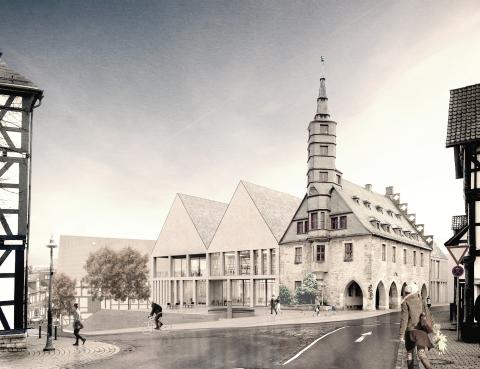
Urban Mining Project in Korbach, Hesse, Germany

About this good practice
The new town hall in the County and Hanseatic town of Korbach is a combination of the renovation and remodelling of the medieval building and a new construction, which replaced an extension from the 1970s. The extension was carefully dismantled so that most of the concrete and even some of the clay bricks could be reused in the new building. At the same time, the architects created an identity-forming overall appearance by continuing the existing roof landscapes and a design language that blends discreetly into the image of the city centre. The whole process involved several steps and challenges. An inventory was carried out for the existing extension and a demolition and disposal concept was developed. Tests were carried out beforehand to assess the suitability of the mineral demolition materials for the production of recycled concrete. One challenge was the local recycling of the large quantities of mineral demolition materials in order to minimize transportation costs and emissions. Suitable places, recyclers and logistic concepts had to be identified. An urban mining concept was drawn up and used for the procurement procedures. In addition to the recycling and use of mineral demolition materials, the future reusability and demountability of the materials and the joining techniques were included as requirements for the planners and trades involved. In the end, 9.848t of mineral materials were recovered, of which 6.006t (61%) were directly reused in the new building.
Expert opinion
Resources needed
The planning team was supplemented by an architect specialised in urban mining design and the construction process was accompanied by experts. These additional expenses were financially supported by the state of Hesse. The share of resource-conserving construction in the total cost is 1.5%.
Evidence of success
60% of the demolition material from the old building was reused in the new one. According to a research project at the University of Kassel, the material resource savings with recycled concrete is relatively high (15%). CO² savings could mainly be realized due to short transport distances and the economical use of cement. An Urban Mining Indicator of about 41% was achieved. The project was recognized by the German Sustainable Building Council (DGNB) as a pioneer of the Urban Mining principle.
Potential for learning or transfer
The example shows that a considerable amount of primary raw materials can be saved in building construction if the raw materials resulting from demolition measures are recovered in a targeted manner and incorporated into new buildings. For example, the exposed concrete for the façade was replaced with mineral demolition materials from the clay brick rubble of the dismantled old building. In terms of design, this refers to the use of recycled materials from the previous building. Around 15 % of the broken concrete could be recycled to a high quality for the structural concrete construction. The example also shows that building owners can plan and build in a resource-conserving and circular manner without incurring significant additional costs. With this in mind, the project is seen as a practical contribution from Hesse to bringing the idea of a European Bauhaus, which was initiated as part of the Green Deal, to life.
Further information
Images
Website
Good practice owner
You can contact the good practice owner below for more detailed information.

